The Wheelchair Guide
Your Wheelchair and Mobility Scooter Resource
Prescribing a Wheelchair: Follow Up Care
Monday, July 13th, 2009
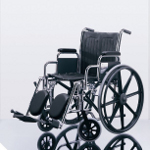 When a doctor prescribes a wheelchair to a user, it is very important that the wheelchair fits the needs of the user. It is also very important that the wheelchair user have a great deal of input over the process, because not only must their physical needs be met, but there are a number of other considerations, like where the person intends to primarily use their wheelchair, that should be considered.
When a doctor prescribes a wheelchair to a user, it is very important that the wheelchair fits the needs of the user. It is also very important that the wheelchair user have a great deal of input over the process, because not only must their physical needs be met, but there are a number of other considerations, like where the person intends to primarily use their wheelchair, that should be considered.
It is encouraged that new wheelchair users also talk with experienced wheelchair users and do a good deal of research on their own, because often doctors, while very well meaning, are not very experienced with wheelchairs and have never actually used one for an extended period of time. Due to health and safety concerns, it is very important that the wheelchair fits the physical requirements of the user.
Once the wheelchair arrives, everything should be remeasured and the wheelchair fully evaluated to ensure that it does in fact fit the needs of the user, however the doctors responsibility does not stop here. Instead, the wheelchair and its effect on the user should be reevaluated with each visit to the doctor.
One of the most important things that a doctor should look for is how the wheelchair is affecting the posture of its user. This is often something that can not be seen until after the user has been using the wheelchair for some time. Proper posture is essential for wheelchair users, because overtime a poor sitting position can cause a great number of health problems.
The actual condition of the wheelchair should also be checked and the user should be trained in how to properly maintain and care for their wheelchair. This includes lubricating moving parts, removing and cleaning the components, adjusting the anti-tip casters, and regularly checking the wheelchairs bolts for tightness. Emergency maintenance, such as how to fix a flat tire, should also be shown.
It is also very important that the wheelchair user be trained in how to navigate environmental factors that they might encounter. This includes the ability to move over curbs, navigate steps, and traveling on hills. Proper transfer techniques should also be shown and the user should be trained on how to fall out of the chair and recover. There are several places across the country that offer a sort of wheelchair obstacle course, to help train new wheelchair users and experienced wheelchair users alike.
The doctor should also make sure that the users home area is wheelchair friendly. It may be necessary to widen doors, install ramps, or a wheelchair lift. The doctor should talk with the patient and explain some of the options available.
Evaluating a Manual Wheelchair for Safety and Comfort
Monday, July 6th, 2009
 When ordering a new wheelchair, ensuring that the wheelchair fits the physical requirements of its user is very important for health and safety reasons, but it can also effect mental health.
When ordering a new wheelchair, ensuring that the wheelchair fits the physical requirements of its user is very important for health and safety reasons, but it can also effect mental health.
Ordering a wheelchair is not a decision that should be taken lightly and it is important that the wheelchair user has plenty of input during the process. Once a wheelchair has been ordered, it should constantly be reevaluated to ensure that it is safely meeting the needs of its user. This should be done both the wheelchair user, as well as a doctor.
Once a persons new wheelchair arrives, the prescribing doctor should evaluate the wheelchair to unsure that it is a proper fit for its user. There are a number of adjustments that can be made to the frame to fine-tune the wheelchair, so that the user can gain the maximum mechanical benefit from the wheelchair.
For manual wheelchairs, since they require a good deal of upper body strength to use, the comfort of the arms in relation to the manual wheelchairs drive wheels is very important. This means, that when in the starting position, the users arms should basically be at rest. This will help to prevent cramps and reduce the effort required to use the wheelchair.
The cushion and seat of the wheelchair should also be treated as a single unit, otherwise, you risk the user being too high or low when the cushion is added. Proper seat height is important, because if the wheelchair is too high, not only will it be uncomfortable, but it will also reduce the efficiency of the wheelchair, which makes it much harder to use. If the seat is too low, it can cause uneven weight distribution.
The height of the backrest is also very important. If it is too high, it can restrict the movements of the shoulder and upper body. However, a backrest that is too low will not provide enough support and can result in poor posture.
The overall width of the wheelchair is another important consideration, because a wheelchair that is too wide can result in the user developing poor posture. This is because the individual will have to lean side to side to reach the wheels. Of course, a wheelchair that is too narrow can cause discomfort and sores, so finding the correct median is essential.
A seat that is too deep can also cause problems, as it can reduce circulation and attribute to poor posture. It can also be dangerous, because the weight of the user is not as evenly distributed, resulting in less weight on the thighs.
Sports Wheelchair Parts Diagram
Tuesday, June 23rd, 2009
There are a great number of wheelchairs on the market and it is very important to find one that will fit the needs of its user. The sport wheelchair, or ultralight wheelchair, is very popular, both by people who are very active and those who simply find it easier and more comfortable to use.
*Please Note that some of the items below are not present in the picture, because they are not usually found on a sports wheelchair.
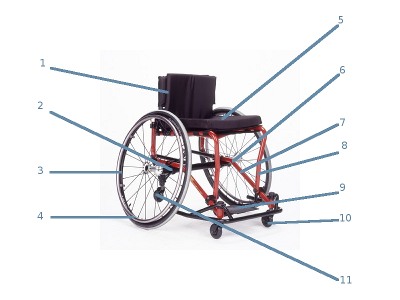
- Backrest
- Rear Axle
- Rear Wheels
- Handrims
- Seat
- Frame
- Traverse Bar
- Front Rigging
- Footrests
- Front Casters
- Anti-Tip Casters
- Brakes
- Tipping Levers
- Seatbelts
- Push Handles
- Upholstry
- Armrests
- Metal Skirt
1. Backrest: The backrest of a sports wheelchair is usually lower than a conventional wheelchair. Typically the backrest will be between 11†and 15â€. The backrest is also usually adjustable and models are also available that span 7†to 11†and 15†to 19â€. A lower backrest can allow for increased upper body movement.
2. Rear Axle: While on a conventional wheelchair, the axle is located directly below the backrest, many sports wheelchairs have adjustable axles. They can be positioned closer to the front of the chair, reducing the wheelbase and making the wheelchair more maneuverable. While typically much more maneuverable and easier to push, a smaller wheelbase also reduces the stability of the wheelchair. To increase stability, at the expense of maneuverability, the axle can be moved backwards towards the rear of the wheelchair. It also makes it a little harder to push, but increase the power of the stroke. Instead of a moving axle, some sports wheelchairs have a moving seat instead.
3. Rear Wheels: The rear wheels are usually the same size as on conventional wheelchairs, but sometimes for racing larger wheels are used. They feature sealed precision bearings and are designed to be as lightweight as possible. This makes the wheelchair easier to move and reduces friction. They also usually feature a quick release button, so the axle can be moved or wheel replaced quickly and easily. Most use spoked wheels, although some sports wheelchairs have solid molded rims.
Typically pneumatic tires are used, often allowing for a much higher pressure than traditional pneumatic tires. Pneumatic tires are great for outdoors, because they provide better shock absorption outdoors. Like racing bikes, the tires are often very narrow.
Often, the camber of the wheel, its angle, is often adjusted, much like you would adjust a sports car, with the bottom of the wheel farther out than the top. This brings the wheels closer to the users body, allowing for more energy efficiency. A wider wheelbase also offers the advantage of a more stable wheelchair that is also easier to steer.
This can pose a problem when indoors when dealing with narrow doorways and makes transporting the wheelchair more difficult. Some now allow the camber to be quickly adjusted to a “toe in†mode for indoor use though.
4. Handrims: The handrims are typically coated in foam that is covered in vinyl, although the rim itself is made of metal. This makes it easier to grab, however the vinyl can be very slick and result in finger burns. More or less padding can also be added, to deliver a variety of grip sizes.
Often smaller handrims are used, which require more energy to get started, but allow for a higher top speed. The smaller handrims also allow for the individual to maintain their speed easier. In many regards the size of the handrim is much like the different gears on a bike.
Sometimes for those with very limited upper body strength or mobility, small extensions are added to the handrail, which extend away from the wheelchair at an angle, making the wheels easier to turn.
5. Seat: The seat often has pieces of velcro attached to it, allowing cushions and bags to be attached. The lower backrest of the seat allows for a greater range of movement and slightly elevates the knees, improving stability.
6. Frame: The frame of a sports wheelchair is made of metals that are very lightweight, such as aluminum, titanium, and graphite. Often, the entire wheelchair will weigh only 25 pounds, which is about half of what a conventional wheelchair weights. There are some, however, that can weigh as little as 15 pounds. The lighter the frame, the easier it is to propel.
Traditionally the frame of sports wheelchairs had been rigid. This improved its performance and made it much sturdier, but it also made it harder to transport. The seat would have to be folded forward and the larger rear wheels would be removed. However, as of late, several manufacturers have begun making folding sports wheelchairs, which makes transportation much easier.
7. Traverse bar: The traverse bar replaces the crossbars found on conventional wheelchairs and helps make the frame sturdier. On folding sports wheelchairs, the frames are equipped with locks to prevent it from folding unless needed.
8. Front Rigging: The front rigging refers to the footrest and the bars that connect it to the frame. Traditionally, the front rigging was not detachable, which improved the stability of the frame. However, this could make transferring into and out of the chair more difficult, some some sports wheelchairs now feature detachable and swing away front rigging.
9. Footrests: The footrest is typically one piece and made of several metal tubes, instead of a platform. It is usually closer to the frame than conventional wheelchairs, reducing the sports wheelchairs turning radius.
10. Front Casters: The front casters are typically made out of solid polyurethane, although some use pneumatic or solid rubber tires. The casters are smaller than those on a conventional wheelchair, usually only 4†to 5†in diameter. However, on racing wheelchairs larger front casters are often used.
11. Anti-Tip Casters: Anti-Tip casters prevent the wheelchair from tipping backwards completely and are often not included on newer wheelchairs.
12. Brakes: Most sports wheelchairs do not have brakes, although some choose to use them. If used, scissor brakes are most popular and mounted lower down on the frame, so the users hand does not become entangled when pushing or the brake accidentally activated. (Not Pictured)
13. Tipping Levers: Typically the tipping lever, which makes it easier for someone pushing the wheelchair to tip the wheelchair backwards and navigate curbs, are much smaller than those on conventional wheelchairs. (Not Pictured)
14. Seatbelts: Seatbelts are usually available for most sports wheelchairs as an option. Some wheelchair users that are very active will use a safety harness to provide more support. (Not Pictured)
15. Push Handles: Many sports wheelchairs do not have push handles, because of the added weight. Instead, fabric straps are added to the back of the seat, to provide a handhold. Some, however, do have push handles. (Not Pictured)
16. Upholstry: Most sports wheelchairs have reinforced nylon or darcon upholstry. This is very lightweight and strong, but unlike vinyl, it is not as easy to clear. (Not Pictured)
17. Armrests: Most sports wheelchairs do not have armrest, which reduces the weight, while allowing the user a better pushing angle. It also increases the users range of upper body movement. (Not Pictured)
If armrests are present, they are usually lightweight and removable. Typically they are not strong enough for the user to use them to transfer into and out of the wheelchair.
18. Metal Skirt: A metal skirt is also usually not present, for both wheelchairs with and without armrests, so the user will risk dirtying their clothes or catching them in the wheels. (Not Pictured)
Other Types of Sports Wheelchairs
There are many different popular wheelchair sports and almost all of these types of sports use a slightly different wheelchair design. For example, the footrest and front rigging of a wheelchair that will be used for wheelchair basketball has a built in foot guard to add more protection. Wheelchairs for wheelchair rugby have an even more protective front guard, as well as more protection around the wheels.
Wheelchairs that are used for racing are elongated to provide stability, so the front wheels often extend several feet from the wheelchairs seat. Since there is so much diversity among the design of sports wheelchair, it is important to decide what you want to use the wheelchair for and to speak with a professional or other wheelchair user to determine what type of wheelchair will be best. It is also not uncommon for many wheelchair users to prefer the design of a sports wheelchair, even if they do not intend to directly use it to play sports.
Manual Wheelchairs for Seniors
Monday, May 18th, 2009
For a senior, walking for extended periods of time can often be very difficult, which is often the result of injuries or in some cases diseases, such as arthritis. Finding a way to increase accessibility and mobility is very important and often a manual wheelchair will offer the least expensive option for a senior.
A Brief Introduction to Manual Wheelchairs
 The wheelchair is probably the most well recognized and well known mobility aid, and its origins can be traced back many thousands of years. However, the modern wheelchair, with its steel tubed frame, two large wheels in back, and smaller wheels in front, is actually a fairly recent inventions. These manual wheelchairs, which can be found at virtually any hospital, store, or airport, are based off of the E & J wheelchair, which was first developed and refined during the 1920′s and 30′s.
The wheelchair is probably the most well recognized and well known mobility aid, and its origins can be traced back many thousands of years. However, the modern wheelchair, with its steel tubed frame, two large wheels in back, and smaller wheels in front, is actually a fairly recent inventions. These manual wheelchairs, which can be found at virtually any hospital, store, or airport, are based off of the E & J wheelchair, which was first developed and refined during the 1920′s and 30′s.
The E & J wheelchair, which features lightweight steel tubing and can be easily folded to make transportation easier, is still around today and serves as the basis for most manual wheelchairs. In fact, early electric wheelchairs also used the E & J design. Today there are many adaptations of the E & J wheelchair and many improvements have been made to increase durability, reduce weight, and improve comfort.
Seniors and Manual Wheelchairs
For a senior, a manual wheelchair is often one of the easiest ways to make getting from point a to point b easier. However, using a manual wheelchair requires a good deal of upper body strength, so as a result, most seniors who use manual wheelchairs rely on a family, friend, or caretaker member to push the wheelchair.
Due to their lightweight and lower cost, manual wheelchairs do make an excellent choice for traveling or going places, like an amusement park, where a lot of walking is required. This is of course, as long as there is someone available to operate the wheelchair.
In addition to the large rear wheels and smaller front wheels, manual wheelchairs also include anti-tip casters. Ant-tip casters extend from the rear of the wheelchair, usually at least six inches from the ground. In the event that the wheelchair is tipped backwards, the anti-tip casters make contact with the ground, keeping the wheelchair from completely tipping over.
Seniors and Transport Chairs
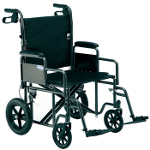 If the senior is not going to be using the wheelchair at all, transport wheelchair, which are also called transfer chairs, are available as well. A transfer chair is similar to a wheelchair, however it does not feature the large rear wheels, which make it possible for the wheelchair user to roll the chair independently, but are instead designed to make it easier for a caretaker or family member to roll the wheelchair. These are often a good choice because they are typically lighter and smaller, making them easier for a caretaker to use.
If the senior is not going to be using the wheelchair at all, transport wheelchair, which are also called transfer chairs, are available as well. A transfer chair is similar to a wheelchair, however it does not feature the large rear wheels, which make it possible for the wheelchair user to roll the chair independently, but are instead designed to make it easier for a caretaker or family member to roll the wheelchair. These are often a good choice because they are typically lighter and smaller, making them easier for a caretaker to use.
Pros and Cons of Manual Wheelchairs for Seniors
While manual wheelchairs or transfer chairs are often the easiest type of mobility aid to procure and are also often the most cost effective option, for a senior, they are often not the easiest type of mobility aid for a senior to use.
For use around the home, it could be a good choice, as they are very maneuverable and in such a small area, it would not require too much effort to use the chair. For long distances though, using a manual wheelchair could quickly become tiring for a senior, so manual wheelchairs might not provide the best choice for a senior who lives independently.
Manual Wheelchair Parts Diagram
Monday, April 20th, 2009
Today, there are a number of different wheelchairs available, but the most common is the steel framed wheelchair. This type of manual wheelchair shares the E & J design, which was developed over eighty years ago, and is the type found in most hospitals. They are also referred to as Traditional wheelchairs, standard wheelchairs, or Conventional Wheelchairs.
Below, you will find a diagram of a traditional wheelchair and a list of its components. Click on any of the links to find out its description or you can scroll down the page.
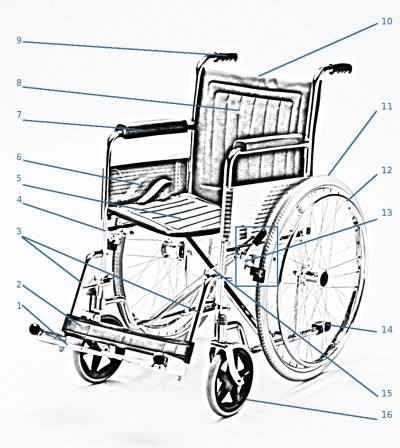
- Footrest
- Legrest
- Front Rigging
- Frame
- Seat
- Metal Skirt
- Armrests
- Backrest
- Push Handles
- Push Axle
- Rear Wheels
- Handrims
- Brakes
- Tipping Lever
- Crossbars
- Caster Wheels
- Anti-Tip Casters (Not Pictured)
1. Footrest: The footrests, which are also called footplates and footpedals, can be adjusted to accommodate different lengths and can also be rotated.
2. Legrest: The legrest extends from the front of the wheelchair and the footrest is attached to the legrest.
3. Front Rigging: The front rigging refers to the footrest arm and the legrest as a single unit. In most conventional wheelchairs, the front rigging can be removed, but this is not always the case in less expensive models. It can also often be elevated to provide an elevated leg rest.
4. Frame: The conventional wheelchairs frame is made out of cold rolled steel that is chrome plated. The frame is the heaviest part of the wheelchair and it can weigh up to 50 pounds, but a stainless steel frame is also available that weighs about ten pounds less.
5. Seat: The seat, like the other fabric parts of a conventional wheelchair, is made from vinyl and uses a sling design. Multiple colors are often available and the vinyl fabric makes it very easy to clean.
6. Metal Skirt: The metal skirt is installed on either side of a conventional wheelchair between the armrests. It is designed to protect the users clothes from dirt, moisture, and debris that can be kicked up by the wheels. Metal Skirts also prevent the users clothes from becoming caught in the wheelchair.
7. Armrests: There are two types of armrests: Full length and Desk Type. The armrests are secured to the frame in two places and are designed to be very sturdy.
8. Backrest: The Backrest height is fixed and typically is about 16 ½ inches high. However, reclining backrests and extending backrest are available as options for most conventional wheelchairs.
9. Push handles: The Push Handles are located on the back of the wheelchair and rubber handles are installed to make them more comfortable.
10. Push Axle: The Push Axle ensures provides support for the push handles and is at a fixed height.
11. Rear Wheels: Typically the rear wheels will be 24 inches in diameter. Both Pneumatic and Solid tires are used. The rear wheels are used for manual propulsion of the wheelchair.
12. Handrims: The handrims extend outwards from the rear wheel. They are typically chrome plated and are used to propel the wheelchair.
13. Brakes: The brakes are located on the large rear wheels. They are typically located on the front of the wheel next to the bottom of the seat.
14. Tipping Lever: The tipping lever extends from the bottom of the frame and is designed to make it easier to move the wheelchair over obstacles, such as curbs. The person pushing the wheelchair will put weight on the tipping lever, which causes the wheelchair to tip backwards.
15. Crossbars: The crossbars are located under the seat and allow the wheelchair to be easily folded for storage and transportation. There are typically no locks to keep the conventional wheelchair from folding, but instead the weight of the user prevents the wheelchair from being folded.
16. Caster Wheels: The wheels of a conventional wheelchair are called caster wheels and are typically 8 inches in diameter. They are typically made of solid rubber, but for outdoor use pneumatic tires are recommended.
17. Anti-Tip Casters (Not Pictured): Anti-Tip Casters are not always present on conventional wheelchairs, but they can usually be added. They are designed to prevent the wheelchair from tipping over backwards. In the event that the wheelchair tips over too far, the anti-tip casters make contact with the ground, preventing it from completely tipping over.
The conventional wheelchair remains one of the most popular and recognized type of manual wheelchairs available. They are often available in a number of different colors and many offer features to make them easier to use, such as removable armrests to make transferring into and out of the wheelchair easier. They can be seen in public areas, like hotels, airports, grocery stores, and hospitals, which offer wheelchairs for their patrons to use.
Challenges Faced by New Wheelchair Users
Thursday, April 16th, 2009
 Today, there are a number of different types of wheelchairs available. There are literally hundreds of different features and designs that are available to help fit the needs of wheelchair users. For the new wheelchair user, choosing the right wheelchair can often be a very difficult and confusing task.
Today, there are a number of different types of wheelchairs available. There are literally hundreds of different features and designs that are available to help fit the needs of wheelchair users. For the new wheelchair user, choosing the right wheelchair can often be a very difficult and confusing task.
Usually when an individual gets their first wheelchair, they do not know a lot about how wheelchairs work and what features will fit their needs. Often, a doctor will prescribe a wheelchair as part of their treatment and then take measurements of the individual to determine what type of wheelchair to order. There are actually a number of problems that can arise from this process, but they typically are caused by the patients own lack of knowledge of wheelchairs and the fact that the doctor is not a wheelchair user.
Since many doctors have never actually used a wheelchair for an extended period of time, through no fault of their own, they might not be the best resource for fitting an individual to a wheelchair. The patient, who is also inexperienced in wheelchairs, turns to the doctor as an expert on wheelchairs, but this is not going to always be the case.
Instead, the doctors experience with wheelchairs is often limited to a few days of training during college, so they measure the patient and plug the numbers into a worksheet to determine the proper dimensions. As a result, the wheelchair prescribed might not fit the best needs of the patient.
This is, of course, not to say that all doctors are poorly, have an ill intentions, or are not a good source of information. However, it is important to understand that since the doctor or specialists has probably never used a wheelchair for an extended period of time, they are not always as knowledgeable about the subject as a person might think.
To help deal with these challenges, there are a number of things the wheelchair user can do. First and foremost, it is a good idea to do some research about wheelchairs. This can involve reading articles about wheelchairs, but it is highly recommended to also talk with someone else who uses a wheelchair, because they offer a wealth of information.
Another great source of information is actually wheelchair salesman. They quite often know a great deal about wheelchairs and can be a great resource. However, since they are a salesman, it is imperative to remember they want to sell you a wheelchair and so, might not provide you a completely objective view. Instead, they will likely only mention products they offer, so it is very important to take what they say with a grain of salt.
One of the major parts of determining what type of wheelchair is best, will revolve around where the wheelchair will be used and the physical abilities of the rider. Since manual wheelchairs can be very strenuous, someone with very limited mobility might not be able to successfully use it, the physical abilities of the wheelchair user will be one of the most important considerations.
There are also a number of features and adjustments that can be made to the wheelchair to make it more comfortable and usable. For instance, some manual wheelchairs do not have armrests, which can make it more maneuverable, less strenuous on the arms, and easier to move under a table. Others have lowered backs, which make turning around in the wheelchair easier, or are designed to move much faster than traditional wheelchairs. This can be one area where an existing wheelchair user can offer excellent insight, but remember that some of these factors will come down to personal preference.
Understanding the options available and doing a good bit of research, can make finding the right wheelchair much easier.
For the wheelchair user, being involved in the wheelchair selection is imperative and one of the most important things they can do, because when a wheelchair is prescribed strictly by the books and without input from the patient, it will not always fully meet their needs.
The Beginning of the Modern Manual Wheelchair
Saturday, April 4th, 2009
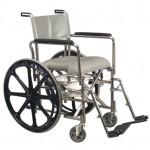 For most, the image of the manual wheelchair is very well known and the first thought when the word wheelchair is mentioned. They are also the oldest type of wheelchair, with records of manual wheelchairs dating back many thousands of years. Of course, these early wheelchairs looked a great deal different from the manual wheelchair of today.
For most, the image of the manual wheelchair is very well known and the first thought when the word wheelchair is mentioned. They are also the oldest type of wheelchair, with records of manual wheelchairs dating back many thousands of years. Of course, these early wheelchairs looked a great deal different from the manual wheelchair of today.
Some of the earliest records of wheelchairs date back to the early Asian empires and are known about only because of the images found by historians. These devices were often simply just wheeled carts and were even sometimes pulled by animals. As time progressed, the wheelchair would continue to develop, but there was not a real standard until the late 1800′s. Up until this point, wheelchairs came in many different sizes and often very cost prohibitive. In most cases, these early wheelchairs were only available to nobility, who had them custom built.
By the beginning of the 1900′s, a wicker wheelchair had become popular, but it was rather heavy to use and could not be self propelled. This changed with the development of the E & J wheelchair. The E & J wheelchair used hollow steel tubing to provide a strong, but lightweight frame. It could also be folded to take up less space and featured large wheels in the back. The wheels were designed so that the wheelchair user could propel themselves without assistance. Since the wheelchair could be folded and was so lightweight, it could be easily traveled with, making it very popular.
Around the same time that the E & J wheelchair was developed, World War II began. During the previous war, World War I, there had been a number of wounded soldiers, but due to the medical conditions, there was not that high of a survival rate. However, by the time World War II had began, there had been a number of improvements in medical care. One of the most important being the discovery of penicillin, which is a powerful antibiotic. As a result, there was large increase soldiers who survived as paraplegics. This increase would drive demand for the E & J wheelchair.
This early wheelchair would form the basis for the modern wheelchair and its basic design is still used today.. Its design being used in almost all forms of manual wheelchairs.
Wheelchair Basketball
Monday, November 10th, 2008
Wheelchairs have been used pretty much since the beginning of time, but until the 1900′s, they really didn’t resemble the wheelchairs of today. By the 1930′s, there were several steel tubed wheelchairs available that closely resemble the type of chair you see today. It was also around this time that wheelchairs sports first became popular.
The late 1930′s until the mid 1940′s, were a very violent time. Many millions of people lost their lives during World War II, but there were also a lot of medical advances, such as the use of penicillin to fight infection. Due to these advances, there was an increased number of soldiers who survived serious injuries, but were left disabled. It was this influx of disabled veterans that would lead to the development of wheelchair sports.
One of the first wheelchair sports to be played was wheelchair basketball. The first recorded game between veterans took place in 1946, but it is usually attributed, at least in part, to a German neurologist named Ludwig Guttmann. Guttmann fled Germany during the beginning of the Second World War. After the war, he founded the National Spinal Injuries Centre, which was located near London in Stoke Mandeville Hospital. He firmly believed that sports were an integral part of rehabilitation and would go on to found the Stoke Mandeville Wheelchair Games, which were the predecessor to the Paralympics.
After that first game of wheelchair basketball in 1946, the popularity would quickly spread among veterans and others who used wheelchairs. It became a part of the Stoke Mandeville Wheelchair Games in 1956 and the International Wheelchair Basketball Federation was founded in 1973. Today it is played by thousands in countries all over the World.
The Basics
Wheelchair basketball is played on a regulation basketball court and the rules are based off of the official NCAA rules, with some changes to address the needs of those in wheelchairs.
Generally in order to play, the individual must be affected by some sort of leg disability or paralysis that affects the lower part of their body, but there are some teams that have able bodied players on them. To achieve a balance, each player is ranked according to their abilities. The players are classified by their disability, for instance a player with complete motor loss would be classified as a Class I player. There is a set amount of points attached to each classification and the total point value of a teams active players can not be greater than 12. This is designed to create a team balance.
The wheelchair used to play wheelchair basketball must also meet several requirements. The height of the seat should not be greater than 21†and the foot rest should not be higher than 5â€. A seat cushion is permitted for each player, but it can not exceed 2†to 4†depending on the players classification. The wheelchairs are usually outfitted with anti-tip bars and other protective tools
General contact rules apply, such as charging and blocking, and the wheelchair is considered part of the players body. Players in possession of the ball may push their wheels to advance, but they can not push more than twice without either dribbling or passing the ball. Pushing more than twice is considered traveling.
A player will loose possession of the ball if they make any contact with the floor. This includes if the wheelchair tips back far enough that the anti-tip wheels make contact with the floor. Generally if a player falls from their chair, the referees will not stop the game unless there is a danger to the player.